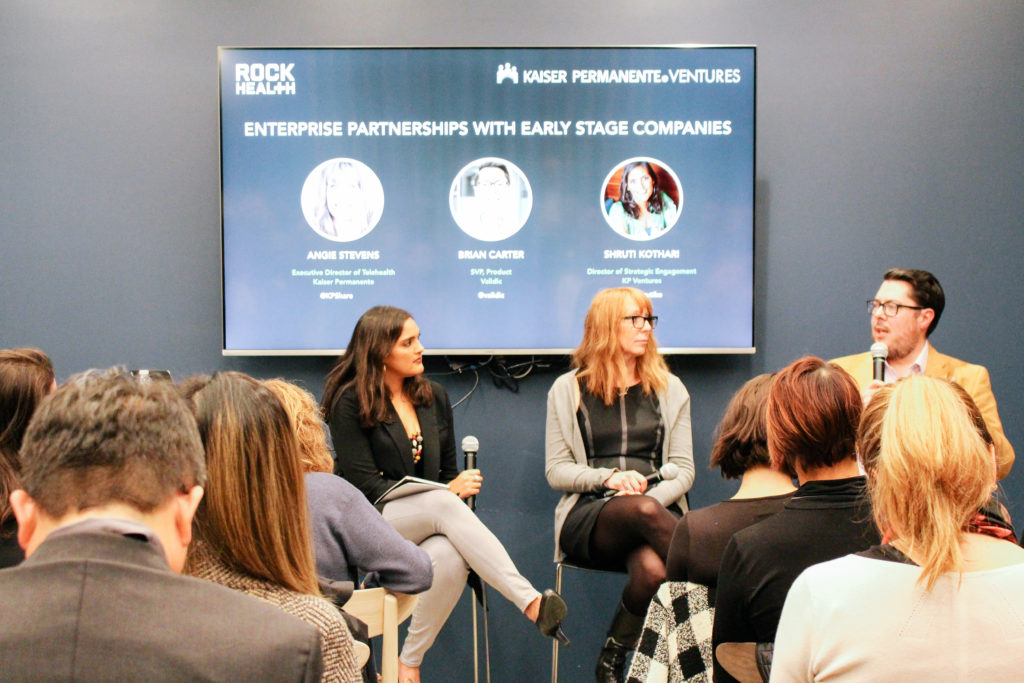What it takes to build a successful enterprise-startup partnership in digital health

To ultimately serve patients, most digital health solutions go to market via large enterprises, whether through payers, providers, biopharma, or employers. The size and complexity of these organizations mean a startup’s technology alone is rarely enough to drive a sale and broad adoption. That’s why effective digital health companies build expertise not just in their product, but in cultivating relationships with large enterprises and implementing solutions across them to reach patient populations at scale.
Last week, we co-hosted an event with Kaiser Permanente Ventures (KPV) that brought together leaders from Kaiser Permanente (KP) and Validic to share the makings of a successful enterprise-startup partnership. Validic is a KPV portfolio company, and has been working with KP since 2015 to integrate patient-generated data into the provider EHR workflow, enabling the care team to monitor and manage patients outside of the acute care setting. In a conversation with KPV’s Director of Strategic Engagement Shruti Kothari, KP’s Executive Director of Telehealth Angie Stevens, and Validic’s SVP of Product Brian Carter discussed what it takes to build a lasting, impactful alliance. Listen below for the full conversation on the Rock Health Podcast—and read on for key takeaways for digital health companies seeking to partner with enterprise.
Both parties should be on the same page when committing to a partnership above and beyond a traditional customer relationship
KP was deploying a range of remote monitoring pilots when Stevens’s telehealth team aligned stakeholders across the organization to converge on shared goals. This resulted in an organization-wide request for proposal (RFP) for a remote monitoring platform. Validic won the contract over an established vendor, largely because of its willingness to collaboratively partner with KP. Stevens noted Validic’s tech was not where it needed to be, but she was convinced of Validic’s openness to KP informing the product’s growth. Carter emphasized this degree of collaboration still stands—two members of his product team were on the phone with Stevens’ team just this past week. And when Validic is considering the next strategic hill to conquer, the product team will “fill a whiteboard with ideas” alongside Stevens and her team. This degree of integration boosts Validic’s understanding of customer needs, and ensures KP is getting high-value from the partnership. Managing this type of partnership requires bandwidth and relationship-building—vendors will also have strictly customer-vendor relationships—but this distinction should be clear at the outset.
The best enterprise partners understand they can’t always be the number one priority
Validic looks for “partners who get that our long term viability and success is in their best interest.” This is critically important, so the enterprise company gives the digital health company the space and flexibility needed to pursue other contracts. Stevens and Carter acknowledged (and joked about) the ongoing tug-of-war they often find themselves in, with Validic weighing how much it can commit to KP’s requests alongside the priorities of its other customers.
When it develops solutions in partnership with enterprises like KP, Validic is careful to build “market grade” products—ones it can sell to others as well. Stevens offered support for this approach, acknowledging that “we can suck the life out of a small vendor.” She advised startups to only dedicate a certain percentage of their time to a “big fish” like KP, as it reduces risk for the startup—and, by association, for KP. A good enterprise partner shouldn’t want or expect a digital health company to put all its eggs in one basket.

Change management isn’t the exclusive responsibility of big organizations—startups should bring their own expertise in implementing and scaling solutions
Carter noted that the challenges of working with a large organization are apparent from the get-go: “When people from these health systems come meet with us, it’s often the first time they are meeting each other.” Stevens echoed this sentiment, noting that across its eight regions, KP often runs pilots, but rarely coordinates at an enterprise level. Early on, Validic recognized it couldn’t just rely on the enterprise to have a defined process for partnership with external vendors—it would have to bring its own change management and implementation expertise to bear.
Over recent years, KP has also built up its muscle memory to scale transformative solutions across its operations and developed a playbook to guide implementation of Validic’s technology across regions. Carter finds that not all health systems are as prepared for the commitment a partnership requires, and he works to contextualize goals by discussing the resources required. For instance, a partner organization wanted to have 50K users by the end of a year—so he coached them on what their support team would need to look like to get there.
For KP, successful adoption of Validic’s solution meant bringing in the patient perspective early and often. KP found that some patients needed training, sometimes with basic setup with the smartphone app. In response, KP now makes monitoring devices available at its pharmacies and trains staff to help patients use Validic’s technology. KP and Validic also created a support team that members can call upon to receive ongoing support. As Carter explained, “patients don’t want to be engaged in managing their health condition on a daily basis. We make the tech as invisible as possible.”
Validic brings lessons learned from implementing at KP to relationships with its other partners. In this way, startups serve an important market function as knowledge diffusers about how to effectively implement across large (often siloed) healthcare organizations.
One final tidbit about KP’s digital partner mix: Stevens is only aware of two vendors that have KP member personal health information (PHI) in the cloud—and both work with her telehealth team. Startups should brace themselves for extra scrutiny when proposing cloud offerings to KP, but they shouldn’t be deterred. Stevens urges companies to stick with it because the cloud is where they are going.
Rock Health is building the two-sided market for digital health
Get in touch to learn more about how your enterprise organization can become a Rock Health partner. And join us as we convene enterprise leaders at our Enterprise Insights Series—the events in Boston, DC, and NYC will feature insights from the latest Rock Health research, facilitated networking opportunities, and expert discussions on startup-enterprise partnerships. Request an invite.

